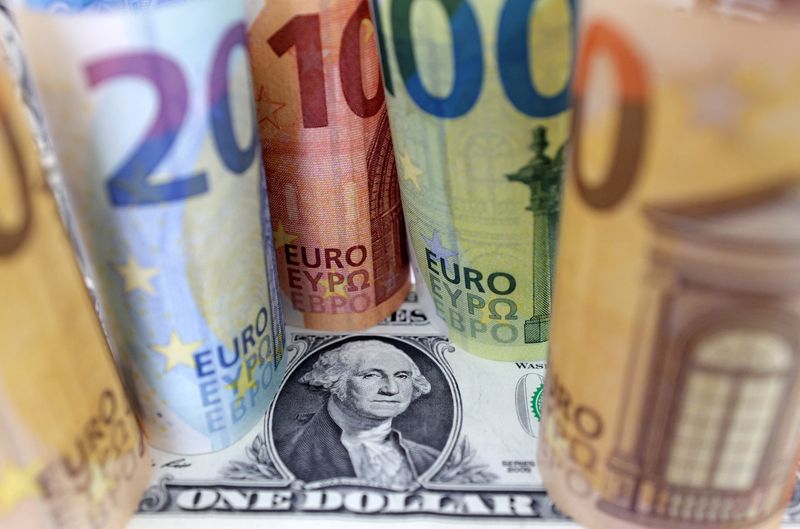By Mike Dolan
LONDON (Reuters) -If you believe the options market, the world's major currencies are going nowhere fast this year.
A world of rapidly re-routed trade, political standoffs, pivotal elections, sparky inflation and widening growth gaps between G7 nations - it might reasonably be seen as an ideal incubator for volatility in major currencies.
And yet, even as central banks hit inflection points in their swinging interest rate hiking campaigns of the past two yeas, implied volatility of the major exchange rates has imploded.
Judged by Deutsche Bank (ETR:DBKGn)'s currency VIX index, or CVIX, implied volatility of the world's most traded currency pairs plunged again this month to its lowest level since just before Russia invaded Ukraine two years ago.
It's now less than half the levels seen at the peak of the energy shock that followed - a jolt that, in turn, forced monetary policymakers everywhere to scramble to contain the inflationary spur of soaring oil and natural gas prices and which put Europe on the frontline.
Other measures tally with that. CME Group's (NASDAQ:CME) G5 currency volatility index FXVL has subsided to its lowest level since 2021 and within a whisker of pre-pandemic levels.
Three-month options prices for the dominant exchange rates of euro/dollar, dollar/yen and sterling/dollar - together accounting for three-quarters of CVIX weightings - are all back to where they were at least as far back as the first quarter of 2022.
Sterling "vol" is actually plumbing levels not seen since before COVID-19 hit early in 2020.
If you look further out the horizon - one-year measures are higher - but only just. And these have also cratered to about half the peaks of 2022 and nosedived this month too.
There is still some "skew" embedded in these prices, with euro and sterling "puts" - options to sell these against the dollar over the coming year - remaining pricier than equivalent "calls". But even these premiums, or risk reversals, have shrunk dramatically and are as close to zero as they have been since early 2022.
At its simplest, all this just reflects a lack of demand to hedge against or speculate on potentially sharp currency swings over the remainder of the year at least - or at least not via options. You could, as many currency sales desks do, argue this represents a screaming buy. But few players are biting.
NONPLUSSED OR NONCHALANT?
If it were just nonchalance, it would be peculiar.
The year ahead includes potentially seismic elections in both the U.S. and Britain and a likely return of Bank of Japan interest rates to positive territory for the first time in eight years.
It's tempting, given the historical milestones, to think it may have something to do with "geo-economics".
Might a growing "home bias" among investors obviate the need to worry about currency swings? Or maybe there's less urgency among corporate treasurers now frantically "re-shoring" business and re-routing supply chains closer to home.
Yet low currency "vol" per se may equally suggest the flipside. It should tempt punters to overseas "carry trades" that seek out higher yielding currencies without fear of being side-swiped by violent exchange rates - or even draw funds from expensive Wall Street stocks to better-valued European or Tokyo bourses without taking an FX hit.
All circular arguments, depending on your take.
But there's a more familiar culprit in the dock.
The dollar is still historically overvalued in most people's eyes - its DXY index remains more than one standard deviation above 20-year averages. And it won't give up the ghost until the Federal Reserve starts easing rates - something U.S. central bank policymakers have spent most of the year pushing back and back.
The most surprising aspect - given the yawning gulf in economic performance between a still-booming U.S. and recessionary Europe and Japan - is that the other central banks seem intent on matching the Fed in lockstep.
So much so, that markets are now convinced the Fed, European Central Bank and Bank of England will hold off on cutting rates at least until late July and then all take the plunge together in less than two weeks of scheduled meetings - even if the BoE's decision slips to Aug. 1.
The upshot is little or no fodder in interest rate differentials for currency markets to feed off.
George Saravelos, head of FX research at Deutsche, goes one step further and says that it's less about timing the first cuts and more assessing "terminal rates" of ensuing easing cycles.
And he shows that even on that basis it's hard to see any wedge between the Fed and ECB right now.
Short-dated interest rate futures out to 2027, for example, put the full extent of the Fed and ECB rate-cut cycles within just 10 basis points of each other - about 170 and 160 basis points of easing, respectively, in total.
Using real and nominal 5-year rate spreads as another way to illustrate that, Saravelos questions the setup as unrealistic.
Adding that a pickup in U.S. election risk into November is also likely, he reckons markets seem to be underestimating the potential for more dollar strength if anything.
"For the dollar to rally more, two things need to happen," the Deutsche strategist told clients. "A more significant reassessment of relative terminal rates between the U.S. and the rest of the world - which we believe is warranted - and a greater pricing of U.S. election risk premium, which remains close to zero."

With clarity on all that unlikely until the middle of this year at least - barring a seismic shift in relative economic soundings or unlikely confidence on the outcome of the U.S. election - it seems we're in for months more in the FX doldrums.
The opinions expressed here are those of the author, a columnist for Reuters.